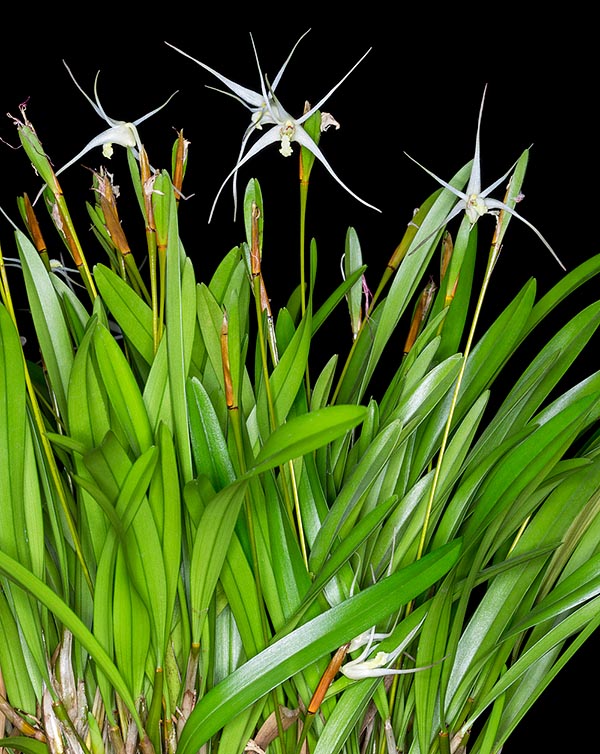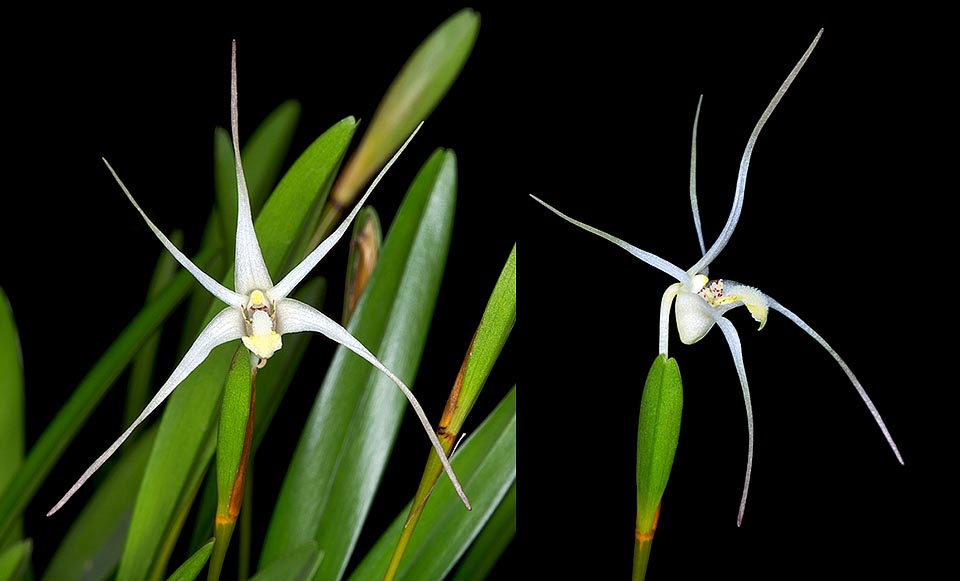Family : Orchidaceae

Text © Pietro Puccio

English translation by Mario Beltramini

Rare in cultivation, Debdrobium nitidissimum is native to Bismarck, Solomon islands and New Guinea © Giuseppe Mazza
The name of the genus is the combination of the Greek substantives “δένδρον” (dendron) = tree and “βίος” (bios) = life, with reference to the numerous species of the genus living on the trees; the scientific name is the superlative of the Latin adjective “nitidus, a, um” = beautiful, elegant.
The Dendrobium nitidissimum Rchb.f. (1876) is an epiphytic species with creeping rhizome that forms dense tufts, characterized by the simultaneous presence of two different types of vegetation, one formed by short pseudobulbs, sterile, the other by tall and thin stems, slightly enlarged at the base, that produce the inflorescences.
The pseudobulbs are fusiform, 2-5 cm long and of 0,4-0,6 cm of diameter, provided at the apex by one single linear leaf with bilobed apex, 8-14 cm long and 0,8-1,2 cm broad, coriaceous.
The floriferous stems, up to more than 30 cm long, are provided at the apex of one single lanceolate leaf with bilobed apex, 2-3 cm long and about 0,6 cm broad, coriaceous. Fasciculate terminal inflorescences, produced at intervals, bearing one single flower, on a pedicel and an ovary about 2,5 cm long, of white colour with lateral lobes of the labellum spotted of purple and yellow median lobe, of about 5 cm of diameter. Long pointed triangular sepals, 3-3,8 cm long and 0,3 cm broad, the lateral united at the base of the column to form a spur (mentum) with obtuse apex, about 0,5 cm long. Linear petals with acute apex, 3-3,5 cm long and 0,2 cm broad, trilobed labellum, about 1,5 cm long and 0,5 cm broad, run by two keels up almost to the apex, with erect triangular lateral lobes at the sides of the column, and spatulate median lobe with wavy margins; the column is about 0,4 cm long. The blooming, of extremely short duration, 8-10 hours, seems to be stimulated by the brusque decrease of the temperature following a heavy rain.

Epiphyte with dense tufts, creeping rhizome, characterized by the simultaneous presence of two types of vegetation: short, sterile, fusiform 2-5 cm long pseudobulbs with a big leaf of 8-14 cm, and floriferous, even 30 cm long, stems having one, 2-3 cm lanceolate leaf, bilobed at the apex. The ephemeral flower lasts 8-10 hours only © Giuseppe Mazza
The species is reported in the appendix II of the CITES (species whose trade is internationally ruled).
Synonyms: Callista nitidissima (Rchb.f.) Kuntze (1891); Dendrobium mettkeanum Kraenzl. (1894); Diplocaulobium nitidissimum (Rchb.f.) Kraenzl. (1910).
→ For general notions about ORCHIDACEAE please click here.
